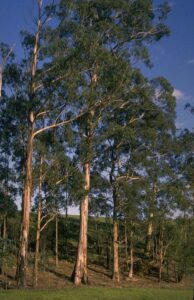To prevent or identify potential tree root damage, here are four types of trees to watch out for.
Illawarra Flame Tree (Brachychiton acerifolius)

The Illawarra flame tree is a deciduous tree native to the subtropical regions of eastern Australia, particularly New South Wales and Queensland. While it is not considered as invasive as other tree species, its ability to self-seed and its widespread root system can disrupt pipes if it grows too close to them.
Physical Characteristics: Illawarra flame trees have distinctive trunks with smooth, grayish bark and lobed, maple-like leaves. They also are known for their bright red bell-shaped flowers that can grow on the tree during flowering season.
Height: Up to 15 meters
Root Span: Fairly extensive, around 5-8 meters
Jacaranda (Jacaranda mimosifolia)

The Jacaranda tree is not native to Australia, but has been widely planted in many parts of the country. It is particularly popular in cities like Sydney and Brisbane, where the streets are often lined with Jacaranda trees. Jacaranda trees are regarded as invasive species and have been naturalized in certain regions of Australia.
Physical Characteristics: It has a relatively open and spreading crown with fern-like lavender-blue leaves.
Height: 12-15 meters
Root Span: Fairly extensive, varies
Liquidambar (Liquidambar styraciflua)

The liquidambar, also known as the American sweetgum, is not native to Australia but has been introduced and cultivated in various parts of the country, especially in temperate regions. This tree’s roots can be highly invasive to urban areas due to how quickly they grow.
Physical Characteristics: Liquidambar trees are deciduous and have star-shaped leaves that turn vibrant shades of red, orange, and yellow during the fall.
Height: 15-45 meters
Root Span: Extensive, varies
Eucalyptus (Eucalyptus globulus)

One of Australia’s most iconic native tree species, eucalyptus trees can be found across many parts of the country. However, the tree’s root system is known to be quite extensive and adaptable to various soil conditions, making them extremely invasive to pipes, pavement, and other urban infrastructure. In some areas, such as near water sources or certain landscapes, eucalyptus trees can impact local water tables and outcompete other vegetation.
Physical Characteristics: Eucalyptus trees are very unique in that they come in various shapes and sizes. In general, though, they have aromatic blue-green sickle-shaped leaves. These leaves have a waxy and leathery texture that keeps them from wilting all year round.
Height: 9-90 meters
Root Span: Very extensive, up to 31 meters
Taking Further Action

If you are thinking of adding one of these trees to your garden or yard, be mindful of planting these trees near buildings, pavements, and underground utilities. Choose appropriate locations that offer sufficient space for root expansion without posing a risk to nearby structures.
For trees known to have invasive root systems, consider installing root barriers during planting. These barriers guide root growth away from sensitive areas, protecting pavements, pipes, and structures from potential damage.
In addition, you should stay up-to-date with tree maintenance to ensure root growth does not encroach on any urban surfaces outside of where it’s planted. Having qualified professionals conduct regular inspections can help you detect early signs of root invasion and address it before it becomes a bigger problem.

